渣打银行风险分析34页PPT
- 格式:ppt
- 大小:2.57 MB
- 文档页数:34
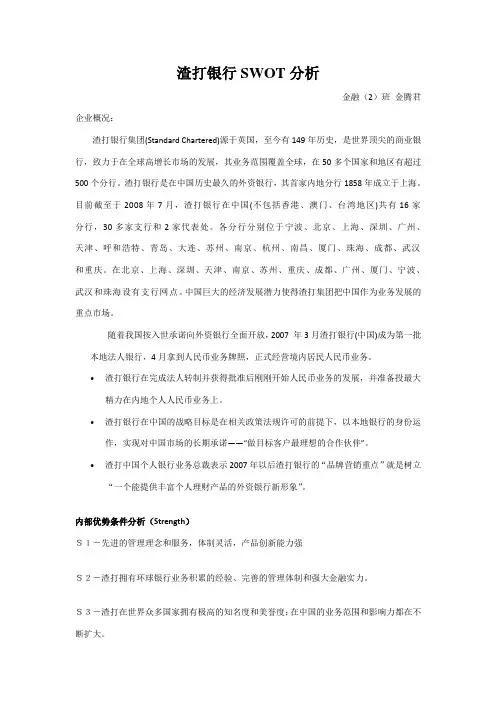
渣打银行SWOT分析金融(2)班金腾君企业概况:渣打银行集团(Standard Chartered)源于英国,至今有149年历史,是世界顶尖的商业银行,致力于在全球高增长市场的发展,其业务范围覆盖全球,在50多个国家和地区有超过500个分行。
渣打银行是在中国历史最久的外资银行,其首家内地分行1858年成立于上海。
目前截至于2008年7月,渣打银行在中国(不包括香港、澳门、台湾地区)共有16家分行,30多家支行和2家代表处。
各分行分别位于宁波、北京、上海、深圳、广州、天津、呼和浩特、青岛、大连、苏州、南京、杭州、南昌、厦门、珠海、成都、武汉和重庆。
在北京、上海、深圳、天津、南京、苏州、重庆、成都、广州、厦门、宁波、武汉和珠海设有支行网点。
中国巨大的经济发展潜力使得渣打集团把中国作为业务发展的重点市场。
随着我国按入世承诺向外资银行全面开放,2007 年3月渣打银行(中国)成为第一批本地法人银行,4月拿到人民币业务牌照,正式经营境内居民人民币业务。
•渣打银行在完成法人转制并获得批准后刚刚开始人民币业务的发展,并准备投最大精力在内地个人人民币业务上。
•渣打银行在中国的战略目标是在相关政策法规许可的前提下,以本地银行的身份运作,实现对中国市场的长期承诺——“做目标客户最理想的合作伙伴”。
•渣打中国个人银行业务总裁表示2007年以后渣打银行的“品牌营销重点”就是树立“一个能提供丰富个人理财产品的外资银行新形象”。
内部优势条件分析(Strength)S1-先进的管理理念和服务,体制灵活,产品创新能力强S2-渣打拥有环球银行业务积累的经验、完善的管理体制和强大金融实力。
S3-渣打在世界众多国家拥有极高的知名度和美誉度;在中国的业务范围和影响力都在不断扩大。
内部劣势条件分析(Weakness)W1-渣打银行业务网点资源明显不足。
W2-新开办的人民币业务客户基础相对较薄弱,需要大力发展新客户。
W3-本土文化融合度不高,品牌影响力不足外部发展机遇(Opportunities)O1-我国2006年12月11日向外资银行全面开放,为外资银行提供了全新的机遇。
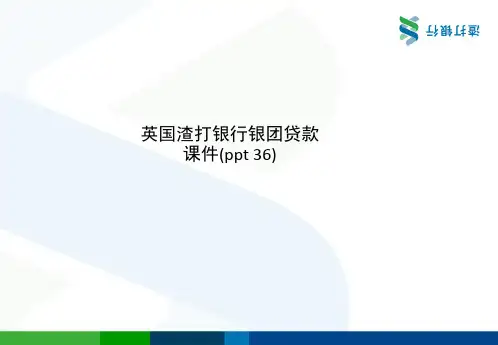

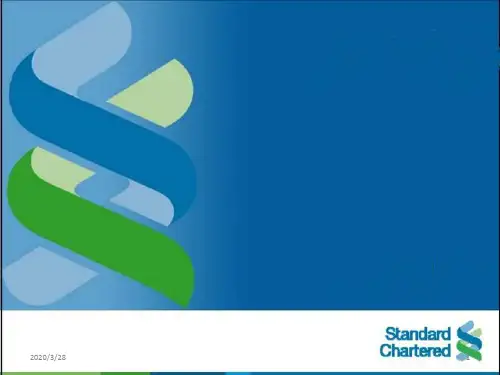



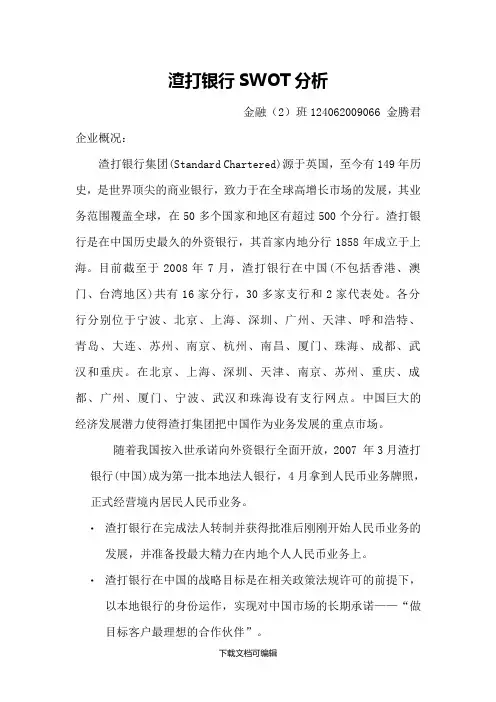
渣打银行SWOT分析金融(2)班124062009066 金腾君企业概况:渣打银行集团(Standard Chartered)源于英国,至今有149年历史,是世界顶尖的商业银行,致力于在全球高增长市场的发展,其业务范围覆盖全球,在50多个国家和地区有超过500个分行。
渣打银行是在中国历史最久的外资银行,其首家内地分行1858年成立于上海。
目前截至于2008年7月,渣打银行在中国(不包括香港、澳门、台湾地区)共有16家分行,30多家支行和2家代表处。
各分行分别位于宁波、北京、上海、深圳、广州、天津、呼和浩特、青岛、大连、苏州、南京、杭州、南昌、厦门、珠海、成都、武汉和重庆。
在北京、上海、深圳、天津、南京、苏州、重庆、成都、广州、厦门、宁波、武汉和珠海设有支行网点。
中国巨大的经济发展潜力使得渣打集团把中国作为业务发展的重点市场。
随着我国按入世承诺向外资银行全面开放,2007 年3月渣打银行(中国)成为第一批本地法人银行,4月拿到人民币业务牌照,正式经营境内居民人民币业务。
•渣打银行在完成法人转制并获得批准后刚刚开始人民币业务的发展,并准备投最大精力在内地个人人民币业务上。
•渣打银行在中国的战略目标是在相关政策法规许可的前提下,以本地银行的身份运作,实现对中国市场的长期承诺——“做目标客户最理想的合作伙伴”。
•渣打中国个人银行业务总裁表示2007年以后渣打银行的“品牌营销重点”就是树立“一个能提供丰富个人理财产品的外资银行新形象”。
内部优势条件分析(Strength)S1-先进的管理理念和服务,体制灵活,产品创新能力强S2-渣打拥有环球银行业务积累的经验、完善的管理体制和强大金融实力。
S3-渣打在世界众多国家拥有极高的知名度和美誉度;在中国的业务范围和影响力都在不断扩大。
内部劣势条件分析(Weakness)W1-渣打银行业务网点资源明显不足。
W2-新开办的人民币业务客户基础相对较薄弱,需要大力发展新客户。
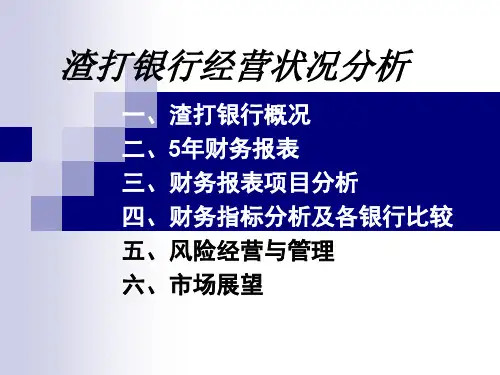
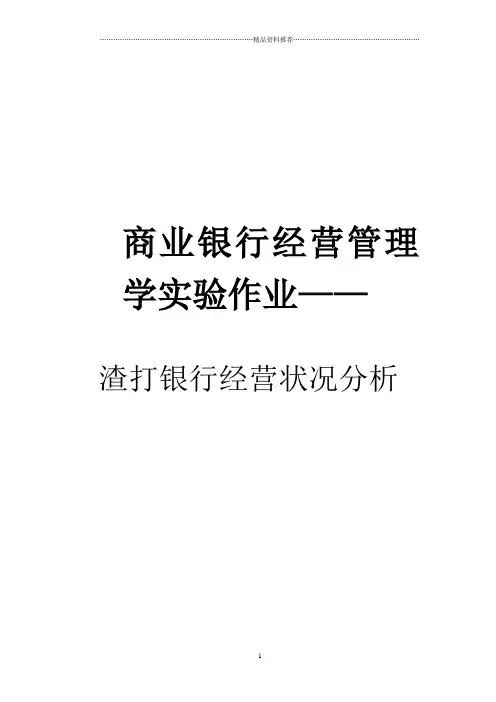
商业银行经营管理学实验作业——渣打银行经营状况分析商业银行经营管理学实验作业——渣打银行经营状况分析金融xxxxx班第x组小组成员:xxXxXxXxxx目录一、渣打银行概况 (5)(一)渣打银行简介 (5)(二)渣打银行部分产品展示 (6)(三)渣打银行最新市场业绩简述 (7)二、渣打银行五年财务报表 (7)(一)综合损益表 (8)(二)综合资产负债表 (9)(三)综合现金流量表 (10)(四)补充资料 (11)三、财务报表项目分析 (12)(一)资产负债表项目分析 (12)(二)损益表项目分析 (14)四、财务指标分析及各银行比较 (15)(一)安全性指标分析及比较 (15)(二)流动性指标分析及比较 (19)(三)盈利性指标分析及比较 (22)五、渣打银行风险管理 (25)(一)信贷风险管理 (26)(二)流动性风险管理 (28)(三)市场风险管理 (30)(四)其他风险管理 (32)六、渣打银行前景展望 (33)(一)最新市场战略及表现 (33)(二)渣打银行前景展望 (35)参考文献 (37)摘要渣打银行是一家业务遍及全球许多国家的商业银行,总部设在英国。
渣打银行主要业务包括零售银行服务如按揭、投资服务、信用卡及个人贷款等,商业银行服务包括现金管理、贸易融资、资金及托管服务等。
截至2012年5月18日,渣打银行在中国大陆(不包括香港、澳门、台湾地区)共有18家分行,30多家支行和2家代表处。
渣打银行拥有雄厚的资本实力,并且始终承诺“一心做好,始终如一”,不断推出创新、具特色的理财产品,一切以股东的权益为首。
渣打银行五年来安全性、流动性、盈利性指标与同业相比均稳定维持在较高水平,与其严谨的管理、正确的策略和领导是分不开的。
在业绩连续几年创下新高后,渣打银行决定专注于亚洲、非洲及中东地区业务,大力发展地方市场,将个人业务与企业业务有效融合互动,用完善的系统、严密的制度、创新的精神,不断开拓更加广阔的市场。
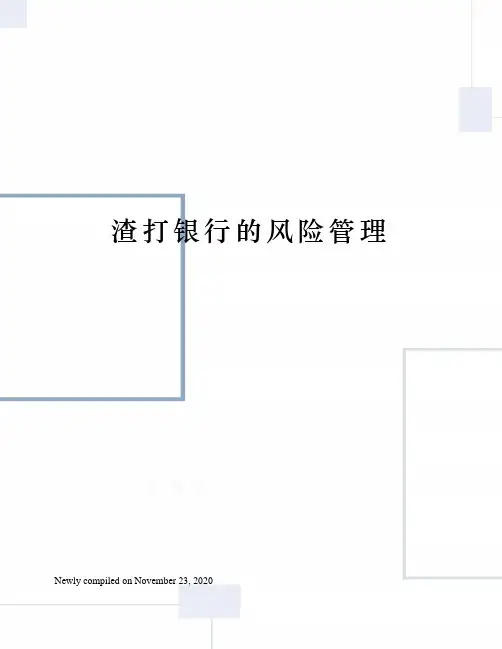
渣打银行的风险管理Newly compiled on November 23, 2020渣打银行的风险管理渣打无抵押贷款风控之道风险控制分“三道”渣打风险控制分“三道”:前道由客户经理完成;中道是指风险分析;后道则是总行的审批。
办理中小企业无抵押贷款除了提供营业执照、地税、国税等公司应有的证件,还要提供持股15%以上股东的身份证作个人的信用担保。
“因为很多中小企业都是和个人直接挂钩的,我们不仅要考核公司的信用,还要考核股东的个人信用。
”业务人员通过电话告诉记者。
在渣打银行中国区负责中小企业理财的总经理、执行副总裁黄丽芬眼里,渣打控制风险的方法分为“科学”和“非科学”两种:“‘科学’的方法其实就是根据企业账面信息进行判断,‘不科学’的办法还是要靠我们去了解企业。
”根据渣打银行在新兴市场的多年经验,对该类市场可能遇到的风险归为八大类:信贷风险、市场风险、国家风险、流动性风险、业务风险、合规管理风险、营运风险和声誉风险。
前四类风险主要和集团的战略相关,而后四种风险则是和各分区、分行的业务和日常管理直接相关。
渣打集团内部的风险管理是按照矩阵式模式来进行的。
在渣打集团总部,有一个专门的审计和风险管理委员会,这是渣打风险管理的中枢机构,该机构独立于其他业务部门单独运作,直接向董事会负责。
在集团的主要业务部门,又有专门独立的风险控制部门,对本部门从事的所有业务进行风险评估和监控,每一项业务的进展都会伴随着一项风险评估报告,风险控制部根据该项业务所可能出现的风险进行预估并标出风险等级。
风险等级分为三级:一般风险、中级风险和高级风险。
根据风险等级的不同,相应地,项目的决策层面和跟踪监督层面也会有所调整。
中国区的“系统职责矩阵”的成型是在最近几年。
在中国区的两大主要业务部门批发银行部和零售银行业务部,都设有专门的风险控制部,而渣打在中国已有的7大分行和6个代表处,又分别设有对应的风险控制部。
一般而言,各操作部门根据集团和部门操作标准和指示负责监控操作过程中的风险,对重大和例外事件必须报告给CORG,如果需要,还必须同样报告给业务部门风险管理委员会和集团风险管理委员会,而这样的报告,在正常的情况下是每月都必须例行的。
试论渣打银行的风险管理渣打银行(Standard Chartered Bank)是一家跨国银行,总部位于英国伦敦。
作为全球化金融机构,渣打银行面临着各种风险,包括信用风险、市场风险、操作风险、法律风险等。
然而,需要承认的是,渣打银行在风险管理方面取得了一定的成果,不断改进其风险管理体系,以应对不断变化的市场环境和监管要求。
首先,渣打银行注重信用风险管理。
作为一家跨国银行,渣打银行在全球范围内运营,与众多客户进行业务合作。
因此,信用风险是该银行面临的重要挑战之一。
渣打银行通过建立完善的信贷评估和风险控制流程,确保贷款和信用有一定的安全保障。
此外,该银行还通过多元化客户群体和分散风险投资组合来减少信用风险。
其次,渣打银行重视市场风险管理。
市场风险主要涉及利率风险、汇率风险和商品价格风险等。
作为一家全球金融机构,渣打银行的市场风险管理涉及多个国家和地区的资产和负债。
该银行通过制定严格的市场风险管理政策,建立风险敞口限制和敏感性分析模型,及时发现并应对市场波动。
此外,渣打银行还加强对外部交易和市场趋势的监控,以及对交易员的风险警示。
再次,渣打银行注重操作风险管理。
操作风险主要涉及人为错误、系统故障和不法行为等。
渣打银行通过建立合规和内控机制,确保各项业务符合法律法规和公司政策。
此外,该银行还加强对员工的培训和教育,提高员工的风险意识和业务素质,从而减少操作风险。
最后,渣打银行注重法律风险管理。
法律风险主要涉及诉讼、合规和监管要求等方面。
渣打银行积极与各国监管机构合作,确保自身业务符合相关法律法规和监管要求。
同时,该银行还与律师事务所等专业机构合作,及时了解和应对法律风险,确保业务持续稳定发展。
综上所述,渣打银行在风险管理方面展现了一定的实力和成果。
通过注重信用风险管理、市场风险管理、操作风险管理和法律风险管理,该银行建立了一套完善的风险管理体系,并不断改进和创新,以适应不断变化的市场环境和监管要求。
尽管银行业务的风险管理具有一定的挑战性,但渣打银行通过积极应对风险,努力保障客户和自身的利益。
IntroductionWelcome to standard charted Bank. This risk handbook will give you an introduction to the various risk related activities within the bank. This handbook is not meant to be a “Bible” on Risk Management but instead will provide you with the background to several key areas within the leading function and will serve as your “first point of reference”. Elaboration and detail of any policy or process will be found in the respective databases and you will be provide a reference to the same in the handbook. Further, if you are in a sales related role, you must also refer to the Relationship Manager Guide, which will equip you on, “How to be a better Relationship manager and become a partner to your clients” .Risk Culture- What does it mean at Standard CharteredWhat is Culture? Webster defines it as:“The set of shared attitudes, values, goals, and practices that characterize a organization”- the key word is …shared‟. We all have different roles to play within the organization but one thing is clear, Standard Chartered can and will only be successful if we all take ownership of risk and accept accountability for our actions. Every one of us can lead by example and ensure that the decisions we make, the actions we take, are to the long term benefit of the bank firstly and that any personal benefit is subordinate.The bank benefits from a strong risk culture and we endeavor to reward good risk behavior in the same way that we reward other achievements, Those of us who demonstrate a sound approach to risk can expect to see this further our careers and be appropriately rewarded. Saving losses is as important as growing revenue.(物质奖励)We expect people to behave responsibly and to bring problems to the fore(在前面)at the earliest possible stage. In the same way that we expect openness and full disclosure from our clients, so we expect it of ourselves. Problem are there to be solved, not hidden.In a good, sound institution risk is an integral part of strategic planning from the top down. Good risk culture derives from good risk behavior, a collegiate approach, open and robust debate on issues of concern and most of all a firm and unwavering commitment to a “No Surprises” philosophy. We will also ensure we all have a clear framework within which to operate and that we all understand what we can and can not do.Business and RiskMost dictionaries define risk as …danger‟ or …the possibility of somet hing harmful or undesirable happening‟. Consequently the intuitive understanding of the world is a “negative” one. However, as a Bank, risk is our business and we profit from managing it. Therefore it is imperative that we understand the risks we face and have robust systems that identify, measure and manage these risks and have people who are risk aware so that we can exploit the opportunities that are presented to us. Specifically we need to ensure when we accept risk, we do so because it fits with our strategy, is within underwriting(保险业) standards, is priced and approved appropriately and is monitored constantly.Risk Principles (also refer Database B 101)The Basic Principles of Risk Management within the bank are:A. We recognize that revenue is earned by accepting risk and we will ensure that business activities are controlled on the basis of risk adjusted return.B. We will be explicit in setting our appetite for risk and we will manage risk to stay within agreed parameters. It follows from this that risk must be quantified wherever possible.C.Risk will be assessed before acceptance and for as long thereafter as we remain exposed to it.D. We will comply with all applicable laws and regulations in every country where we do business, and with the governance standards prescribed for listed companies.E.We will apply high and consistent ethical standards to our relationships with all customers, employees, and other stakeholders.F. Group activities will be undertaken in accordance with fundamental control standards. These Controls will employ the disciplines of planning, monitoring, segregation, authorization and approval, recording, safeguarding, reconciliation, and valuation.Risk TypesOften credit risk is considered as the only risk that lenders need to evaluate when arriving at a lending decision. In an increasingly dynamic and complex marketplace, it is imperative that we consider all the types of risk that could exist and then dimension and evaluate the critical ones so as to focus our limited time and resources on them before arriving at a decision. As a bank we generate most of our revenues by accepting risk of differing types in our lending decisions. For a summary of definitions of the main types of risk, also refer Database B 101. The main types of risk that need to be considered are:Credit RiskIn assessing credit risk we seed to establish the probability that a counterparty will not repay it‟s obligations to the Bank. The better the quality of the customer, the lower is the expected probability of default. The assessment of this risk is carried out by the nature of the counterparty and can be broadly categorized into the following:Corporates –These include Local Franchises and MNC(MultiNational Corporation) segments of the Corporate Bank and are approved by Credit Officers with delegated lending authority within the Country and if beyond their authority then at Regional Credit Officer level or Group level.Non Corporates–These include Governments, Banks, Financial Institutions and Investment Institutions. Given that the nature of these counterparties are very different from that of Corporates, the same are assessed and approved by Markets and Institutions Risk Management (MIRM) which is an independent approving unit within the Risk Manag ement function. MIRM on a centralized basis supports the bank‟s business in setting and approving credit limits on counterparties to support the following activities: 1. Asset Liability Management(资产负债管理)– This is done on a portfolio(投资组合)basis and against pre agreed norms with regard to counterparty rating, nature of instrument and amount of exposure and does not need specific approval on a counterparty basis. These are controlled on an oversight basis with regard to outstanding and credit quality.2. Normal Business–This is done on a product basis (e.g. Trade Finance, FEX,Derivatives, Fixed Income Securities, Syndication‟s, etc) and with reference to a specific counterparty on whom credit limits are established.Sovereign Risk and Country Risk –are they the same?No, Sovereign Risk is the counter-party credit risk of a borrower who is a government or a wholly owned entity of a government. Hence sovereign risk is assessed as part of the risk approval process for Non Corporates and should not be confused with Country Risk.Country Risk (Also refer database B 301 and B 326)Country Risk arises when the bank has a cross border exposure on a counterparty on which we have Credit Risk. Country Risk is the risk that our counterparty is unable to meet its contractual obligations as a result of adverse economic conditions or actions taken by governments in the relevant country. Given that this is independent of the counterparty credit risk, we assess this risk in addition to credit risk. Since the assumption of country risk requires capital allocation, we also price for it in accordance to the risk of the country on which an exposure is being taken, Country risk arises in all cases other than in those that are on-shore transactions in domestic currency. Nominated Country Risk Allocation Holder manage and monitor this risk under the supervision of Group Country Risk in London. (also refer database B327 and B329, for details of allocation holders and country status)A modular e-learning solution is also available on “Peoplewise” for country Risk.Market and Liquidity Risk(Also refer Group Market Risk Policy Database)Unlike Credit and country Risk where the risk needs to be assessed at a counterparty level, Market and Liquidity risk are assessed in the main on a portfolio basis. However, in the case of large or complex exposures this could also be evaluated at a transaction level. Typically these risks are evaluated with the use of sophisticated statistical models which are employed to quantify these risks at transaction or portfolio level. Group Market Risk is responsible for the overall framework and management/ control of market and liquidity risk within the organization. They evaluate and implement the models and validate the assumptions in the models on a continuous basis. At a business and country level, they monitor and control these risks by delegating authority to Local Management who are primarily responsible to comply with the group guidelines. These can be briefly explained as under:1. Market Risk is the risk to the Group‟s earnings and capital due to changes in themarket level of interest rates, securities, foreign exchange and equities, as well as the volatilities of those prices. Group Mark Risk prescribes the unified framework for the assessment and control of market price risk. A risk monitoring limit and reporting structure is set out of portfolios of products, instruments, and income streams, where the economic value is directly or indirectly sensitive to change in variable market price, such as spot foreign exchange or maintain adequate.2. Liquidity risk management involves the ability to manage and maintain adequateliquidity at all times. Good liquidity risk management will result in the bank being in a position(in the normal course of business) to meet al l it‟s obligations, to repay depositors, to fulfil commitments to lend and to meet any other commitments it may have made. OF critical importance is the need to avoid having to liquidate assets or to raise funds at unfavourable terms resulting in financial loss or long term damage to the reputation of the Bank. Prudent liquidity management is of paramount importance as the ultimate cost of a lack of liquidity is being out of business, which we cannot afford.Operational Risk (also refer database B501)In addition to other established risk classes discussed so far, the bank also views Operational risk as a separate risk class. Like Credit, Market and Liquidity risks, Operational Risk too has evolved in the Group and now has it‟s own established policies(also refer database sub chapter B500) and procedures (also refer database sub chapter B525) to facilitate management and measurement.Operational Risk is defined as “The risk that the Group will incur direct or indirect loss due to an event or action causing the failure of technology, processes, infrastructure, personnel and other risks having operational impact. Legal risk is included. This definition excludes strategic/business and reputational risk”.Some of the key developments in this area are enumerated hereunder:1. Operational Risk coverage is now enterprise wide i.e. across front office/middle officeand back office functions in the Group and works on a de-centralised model, with business and countries taking greater responsibility and ownership for day-to-day risk management.2. Group Operational Risk is today an independent risk unit within Group Risk and isresponsible for defining and implementing the Group‟s Operational Risk Policy and framework. In addition to the Operational Risk unit, the Group Operational Risk function also includes Group Insurance and Group Security (including responsibility for the Group‟s Continuity Planning Policy).3. The Operational Risk management framework is also being used to track and managenon-traditional risks like Reputational, Compliance, Social, Ethical and Environmental risk in the Group.4. Risk management at country, business and Group level is an integrated process andis through self-assessment and exception reporting.5. The evolving relationship between a robust control environment and shareholdervalue has resulted in a greater governance focus within organizations. Roles and responsibilities are also being constantly reviewed/enhanced to support the same and Group Audit plays an active role in reviewing the effectiveness of risk management process and framework.6. On the international front Standard Chartered is a member on the Financial ServicesAuthority (FSA) Advisory panel on Operational Risk and the Institute of International Finance(IIF) Working Group on Operational Risk.All employee have a role to play in managing operation risk and compliance with the Group Operational Risk Policy & Procedures is mandatory. You must ensure that your key operational risks are understood, being managed and reported(where significant) to senior management. Within the Wholesale Bank, significant risks should be reported to the Wholesale Bank Risk Committee. Coverage should be across front office, middle office and back office and back office areas and scope should not be restricted to just Service Delivery/Technology issues.Compliance Risk (also refer database B601 and B602)Since Banking and Financial service activities are conducted within a framework of obligations imposed by regulators and national/international law, complying with such requirements is not optional for the bank. The consequences of non-compliance include fines, public reprimands, and enforced supervision of operations or withdrawal of authorization to operate, any of which can lead to reputational loss particularly through adverse publicity in national or international media. Noncompliance with regulatory requirements can also lead to civil or criminal action being taken against the Bank and responsible employees, which is detrimental to our ability to successfully conduct business. Therefore the bank is working towards developing a robust framework of procedures and controls so as to minimize compliance risk and to ensure that everyone understands their roles and responsibilities in this process. All employees are expected to observe the Group Code of Conduct, which must be followed at all times. The increasing importance to the issue of money laundering cannot be overlooked and it is mandatory forall staff to be conversant with the Money Laundering Policy(refer B 507).Reputational Risk (also refer database B701 and J401)Our reputation is one of our most important assets and therefore it is important to understand the implications of putting our “Reputation” at risk. T o protect our (good) reputation we need to ensure that we are seen to conduct business activities in a manner that is in line with the requirements or expectations of all our key stakeholders. Every time we fail to manage one or more of the risks discussed so far in an appropriate manner, the resultant adverse publicity will always impact our reputation as well our revenue generating capability in any given business location. The intuitive way to assess this risk is to ask yourself the question, “If this made it to the Headlines in the newspaper, will it embarrass or harm us in any way?” If the answer is Yes, then escalate to be made and an appropriate decision agreed to. All staff are responsible for the day to day identification and management of reputational risk. It is the duty of every SCB employee to consider the reputational impact of his or her actions. This must be considered at the outset of any course of action. The Wholesale Bank Reputational Risk Committee is responsible to review the reputational risk aspects of proposed transactions (products, lines of business etc) originated within Wholesale Bank and is authorized to approve the reputational risk aspects of the transactions referred to it.Environmental and Social Risk (also refer database B204)With growing awareness about the need to protect the natural environment and concerns with regard to social factors (e.g. employment of child labour), we are exposed to the risks of non-compliance with environmental and social legislation. This risk can emanate either directly from our own actions as a bank or in-directly as a fall out of out counterpartys‟ actions, should they not be in compliance of legislation or take actions that are not acceptable to their regulators. Environmental and Social Risk is part of the total risk associated with lending, it should not be seed as a standalone risk. It needs to be identified, mitigated where possible, and if appropriate priced for, as are all other risks. Risk and Relationship Managers are not expected to be experts in environmental and social issues, however they are expected to be able to use the tools at their disposal to recognize and evaluate the risks associated with lending decisions.Risk Management Framework & Matrix of ResponsibilitiesIn order to ensure that risk is effectively managed when we provide products to our customers, and throughout the period of our relationship with them,, it is necessary to have a robust risk management framework in place and have clarity as to roles and responsibilities.The term risk management framework refers to the structure within which the management of risk is effected within an organization. Building and maintaining this structure requires putting together a mix of the following elements:1. methodology for determining risk appetite2. policies and procedures for managing risk3. models for measuring risk e.g. credit grading4. tools for analyzing risk e.g. spreading balance sheets5. processes for recording and approving credit requests e.g. Business CreditApplication6. the means o delegating and monitoring the use of credit authority7. the management of documentation and limit input8. tools and techniques for monitoring and reporting risk exposures9. the structures for regularly reviewing risk exposures e.g. risk committeesand so on. Just as you can build many different designs of buildings with simple materials such as bricks, steel and cement the above elements can be put together in many combinations depending on the nature of the risks involved. The structure varies therefore according to the type of risk – credit, market and country risks are managed in different ways – and even within credit according to the types of counterparty – multinationals, local corporate, banks and financial institutions, governments all have different credit processes.Overall responsibility for ensuring that there is an appropriate risk management framework in place rests with Group Risk. For Wholesale Bank the responsibility lies with the WB Risk Management team. At country level the SCO will ensure that its requirements are operating effectively.At an officer of the bank, is it your responsibility to ensure that you are aware of the business strategy and underwriting standards in your area. You must also be aware of the policies and procedures that are relevant to the area in which you are working and ensure that you work within their spirit as well as to their letter. Ignorance is no defence so ask if you are unsure how things are supposed to operate in your location and what your authorities are.Risk Management OrganizationAs mentioned earlier, the risk management organization operates at three levels, Group, Functional and Country.Group LevelGroup Risk(GRM) largely based in London has responsibility for ensuring that risk across SCB is recognized and managed effectively. It is support function reporting to an independent Group Executive Director.It ensures that the overall risk management framework is operating effectively. This is done, for example, by putting in place high level Group policies(see section B of the Notes database ot the Group Risk pages of SCyBernet), involvement in significant risk decisions including business strategy and budgets, over-viewing actual exposures and involvement in the various risk committees.Functional LevelThe members of the Function (either WB or CB) risk team based in Singapore have similar responsibilities as GRM but their focus is solely on the function or business they manage. The main differences are the scope of this responsibility is narrower and they must operate within the confines of the authorities given to them and within Group policyboundaries. The risk team will therefore define policies and procedures appropriate to the function and monitor the performance of the business within their area id responsibility. The risk team is independent of the business but work very closely with them. Their remit is global applying equally to countries managed on a segmented and non-segmented basis.Country LevelAt the country level the SCO for a business is responsible for ensuring that risk is managed effectively by setting local risk boundaries, underwriting standards, and ensuring that risk is taken on within those boundaries and that Group and WB policy and procedural requirements are complied with.Other support functions, which impact on WB risk, are:Group Special Assets Management–this unit is responsible for management of delinquent or potentially delinquent accounts to maximize recoveries and minimize losses. It is an independent function, which works very closely with WB and GRM.Audit– the Group Audit function check that policies and procedures are being complied with by operating units and is an independent function so as to ensure no conflict of interest.Risk Policies and ProceduresTo define, regulate and monitor the activities of the bank, various policies and procedures have been put in place. These are available in the Notes database under “Risk Policies and Procedures Database” and in SCyBernet on the Group Risk web page under “Policies and Procedures”. These are the set of ru les and guiding principles covering the provision of credit and related activities and also describe the processes and procedures within the bank. These policies and procedures encompass a wide range of risks (Credit, Country, Reputational, Operational etc.) as discussed earlier in the handbook. It is useful to be familiar with the structure and overall content of this database.The policies in the Bank could be broadly categorized into three –1. Group PoliciesThese set out the broad overall credit policies of Standard Chartered Group for the Conduct of credit business and apply to all counter-parties and to all business functions within the Group. The definitive document in this area is the Group Credit Policy(B 201). The ownership of these policies rest with Group Risk. These are located under Chapter B of the Risk Policies and Procedures Database.2. Functional PoliciesThese are Individual business specific credit policies and procedures, which are developed within the overall guidelines of the group credit policies. The most definitive documents in this area are the C&I Functional Credit Policy (J101) and the Global Markets Credit Policy (J103). These set out the basis credit philosophy and standards by whichbusiness is to be undertaken and credit risk managed within the Wholesale Bank in all territories and business units. Where necessary these are supported by more detailed Polices and Product Programs as appropriate for each business unit. The ownership of these policies rest with the respective businesses that formulate these policies. These are located under Chapter J of the Risk Policies and Procedures Database.3. Country Underwriting StandardsThese are country specific standards that lay down norms for writing business in a specific country and outline variations to either the Group or Functional Level policies. This document essentially outlines the parameters within which business will be conducted within a country that may not necessary have been captured by the higher level policies. The ownership of these standards rest with the Country Head of Business and the Local Senior Credit Officer. These are located in the Country Underwriting Standards DatabaseWhile it is possible to do business with customer on terms differing from those laid down under the above policy framework, this will require a higher level of scrutiny and a clear justification for the deviation.(also refer appendix 1 of Database J101).Having got an appreciation of the structure of the Bank‟s Risk Management organization, and Policies Framework let us now look at how these impact the conduct of our business on a day to day basis. Most issues that you will be faced with at work can be linked back to a credit policy or procedure and in the unlikely event that it does not or you require any clarification, the Senior Credit Officer of your country should be your first port of call!!!Risk PricingAs business models have evolved so have the measurement models. The bank is now focusing on ensuring that we earn an adequate risk adjusted return on our business relationships. The term we use is Economic Profit.Economic ProfitThis is a risk-adjusted performance measure, which measures profitability after subtracting the expected minimum return to shareholders(i.e. capital charge). By risk adjusted we mean including in the costs of doing business, a risk cost (Expected Loss) and a charge for the capital needed to support the facilities provided to a customer. Using Economic Profit as a performance measure allows the business to understand whether shareholder wealth is being created or destroyed and aligns the goals of the business with that of maximizing shareholder value. Creating sustainable improvement in Economic Profit is synonymous with increasing shareholder value.The consequences of looking at things from an EP point of view are that more emphasis is placed on ensuring adequate returns are earned as negative EP deals mean we are underpriced, under secured or providing too large facilities.Measurement ToolsIn the bank, …Odyssey‟ is the business tool that allows Relationship Managers and Credit Analysts to model Risk Adjusted Return, Economic Profit and Expected Loss for proposed deals and entire customer relationships. The tool is intended to provide directional guidance, and not a prescriptive answer. It is very important that the tool be used with a clear understanding of the methodology, how to interpret the results, and how a single deal fits into the overall customer relationship and Account Plan.Care is needed however as EL and EP are only calculated using a model which is vulnerable to the quality of data inputs and the soundness of the model itself (model risk).Pricing GuidelinesIn order to ensure that a minimum return is obtained on our customer relationships, the bank is progressively introducing Pricing Guidelines at the country level to provide strategic direction to Relationship Managers. Make sure you have a copy of the same. For further details please refer to the Customer Management Process database in Lotus Notes and the Customer Profitability Guide therein which contains a very good and detailed explanation of all the measures, etc.Also, look out for a modular e-learning solution is …Peoplewise‟on Pricing for Risk (available by 06/2003).Management of Customers/CounterpartiesNot having the right type of customer can often be the root of all problems and hence a good place to start would be to know the type of customers that the bank would normally do business with. This is driven by the country specific business strategy of the bank and could vary from one country to another e.g. whilst we may be willing to do business with middle market customers in one or more countries the same may not be the case for all countries.Knowing our customers well is a fundamental credit principle. Failure to do so will mean that we will not understand the risks associated with doing business with the customer resulting in inaccurate credit ratings and inappropriate credit facilities being provided. The following section highlights the overall mix of bank customers and the manner in which they are categorized within the bank. This is categorization is necessitated due to。
商业银行经营管理学实验作业——渣打银行经营状况分析商业银行经营管理学实验作业——渣打银行经营状况分析金融xxxxx班第x组小组成员:xxXxXxXxxx目录一、渣打银行概况 (5)(一)渣打银行简介 (5)(二)渣打银行部分产品展示 (6)(三)渣打银行最新市场业绩简述 (7)二、渣打银行五年财务报表 (7)(一)综合损益表 (8)(二)综合资产负债表 (9)(三)综合现金流量表 (10)(四)补充资料 (11)三、财务报表项目分析 (12)(一)资产负债表项目分析 (12)(二)损益表项目分析 (14)四、财务指标分析及各银行比较 (15)(一)安全性指标分析及比较 (15)(二)流动性指标分析及比较 (19)(三)盈利性指标分析及比较 (22)五、渣打银行风险管理 (25)(一)信贷风险管理 (26)(二)流动性风险管理 (28)(三)市场风险管理 (30)(四)其他风险管理 (32)六、渣打银行前景展望 (33)(一)最新市场战略及表现 (33)(二)渣打银行前景展望 (35)参考文献 (37)摘要渣打银行是一家业务遍及全球许多国家的商业银行,总部设在英国。
渣打银行主要业务包括服务如、服务、及个人贷款等,服务包括、、资金及服务等。
截至2012年5月18日,渣打银行在中国大陆(不包括香港、、台湾地区)共有18家分行,30多家支行和2家代表处。
渣打银行拥有雄厚的资本实力,并且始终承诺“一心做好,始终如一”,不断推出创新、具特色的理财产品,一切以股东的权益为首。
渣打银行五年来安全性、流动性、盈利性指标与同业相比均稳定维持在较高水平,与其严谨的管理、正确的策略和领导是分不开的。
在业绩连续几年创下新高后,渣打银行决定专注于亚洲、非洲及中东地区业务,大力发展地方市场,将个人业务与企业业务有效融合互动,用完善的系统、严密的制度、创新的精神,不断开拓更加广阔的市场。
关键词:渣打银行;中国;业绩商业银行经营管理学实验作业——渣打银行经营状况分析一、渣打银行概况(一)渣打银行简介渣打银行,又称标准渣打银行、;总部在英国。